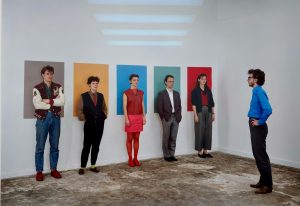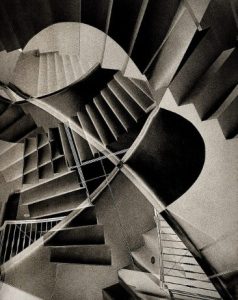דנה זלצמן מנציחה רסיסים של זמן, שברירים בהם המודעות לחולף מתחדדת כמעט לכדי חרדה. לפרטי פרטים היא מציירת מאזניים בהם נשקלים למרבה האבסורד נוצות, פרחי סביון, או שקית נייר כאשר על הכף השניה משקולות מתכת.

Oil on Linen, 56 x 46 cm.
האיקונוגרפיה של מאזניים כמאזני צדק נטועה באמנות מיצרית, בספר המתים שם נשקל ליבם של נפטרים על מאזנים ואם קל ליבם מנוצה הם זוכים לחיי נצח . בנצרות מתואר המלאך מיכאל שוקל נשמות ביום הדין האחרון ובימי הבינים תוארה מעלת הצדק כאשה מכוסת עינים שבידיה חרב ומאזניים.
ציורי המאזיים של זלצמן, כמו מרבית ציוריה נעדרים חגיגיות אך יש בהם הוד ויראה. נוצות לבנות,לחלוטין לא אקזוטיות, או פרחי סביון שצומחים בר ונשיפה מפזרת את זרעיהם לכל עבר, ממלאים קערות מאזניים בוהקות. הם נשקלים מול משקולות ברזל, כאילו מתגרים בהם בצרוף של תקווה תמימות ויאוש, שדומה שעולה מהעבודות היפות- כואבות, מודעות לעצמן עד לשדן, שמציגה זלצמן.
ההשכלה של זלצמן (ילידת 1982) היא מסע בין תחנות שאינן על דרך המלך של האמנות הישראלית. היא למדה במקביל אמנות במכללת תל- חי וציור פיגורטיבי אצל אמיר ניר בקיבוץ גושרים (בשנים 2005-2007), לאחר מכן השתלמה בנורבגיה אצל הצייר עוד נרדרום Odd Nerdrum, המצייר בהשפעה של רמברנדט וקראווג’ו ומציע התבוננות מחודשת בקיטש. מ 2009 עד 2012 למדה ב The Florence Academy of Art, בית ספר אמריקאי במסורת האקדמיות הצרפתיות של המאה ה 19 הפועל בפירנצה.
זלצמן מפתחת אפוא את סגנונה על סמך הכרות עם תולדות האמנות וזרמים עכשווים. בציוריה אזורים שקופים, כמעט רפרוף מכחול על הקנווס באיכות ערפילית, לצד קונקטריות פריכה של אוביקטים שנדמה שניתן למשש אותם ולחוש קור מתכת או חיספוס של עלה. היא חוקרת את המגבלות והכזבים של שיקוף מציאויות. יכולתה ליצור אשליית אוביקט מעוררת התפעלות אך מטרת פעולתה אינה , כפי שניסח זאת שיקספיר ב”המלט”, בדברו על משחק ועל אמנות בכללה ” … להניף ראי אל מול הטבע… “*. זלצמן יוצרת אזור דמדומים של מציאות וכמעט העלמותה, כמו מפצירה בצופים בציורי המאזניים שלה ,לשקול את הפגיע ,החולף, מול המתכת, להתמוגג מיופי ארצי, ולהשתהות לפני גזר הדין.
*(המלט – מערכה 3, תמונה 2,תרגום דורי פרנס)
הטקסט נכתב כטקסט נלווה לתערוכה בגלריה זימאק לאמנות עכשווית
הרשמה לניוזלטר הפירסומי השבועי של “החלון” בנושאי אמנות, אירועים ותערוכות חדשות – www.smadarsheffi.com/?p=925 (הרישום נפרד מהרישום לבלוג )לקבלת הודעות לגבי סיורי אמנות מיוחדים עם ד”ר סמדר שפי אנא כיתבו לכתובת thewindowartsite@gmail.com
Reflections on Dana Zaltzman’s paintings of scales
Dana Zaltzman encapsulates fragments of time, fragile shards in which the awareness of the transient becomes acute to the point of anxiety. She paints scales in painful detail, absurdly weighing feathers, groundsel flowers, or paper bags, with metal weights on the opposite weighing pan.
The iconography of the “scales of justice” is rooted in Egyptian art. The Book of the Dead describes how the heart of the deceased is weighed on a scale: if the heart is lighter than a feather, the departed is awarded eternal life. Christian iconography depicts the Archangel Gabriel weighing souls on Judgment Day, while medieval painters depicted personified Justice as a blindfolded woman holding a sword and a scale.
Dana Zaltzman’s paintings of scales, like the majority of her works, are devoid of festive tones but are imbued with sumptuousness and a sense of awe. White feathers are not exotic at all, neither are groundsels, which grow wild, their seeds dispersed with a breath of wind. These items fill the glowing pans of the scale, being weight against iron weights, as if challenging them with a combination of hope, innocence, and despair which seem to arise from Zaltzman’s oeuvre – beautiful, painful paintings, with consummate self-awareness.
Dana Zaltzman’s (b. 1982, Israel) quest for art education has taken her on a journey off the beaten path of Israeli art. While an art student at the Tel Hai Academic College, she was studying figurative painting in the private studio of Amir Nir on Kibbutz Hagoshrim (2005-2007). She then traveled to Norway to study with Odd Nerdrum, an artist whose works are greatly impacted by Rembrandt and Caravaggio, offering a renewed observation of kitsch. Zaltzman then traveled to Florence to study at the Florence Academy of Art (2009-2012), an American school in Italy, continuing the tradition of 19th century French academic painting.
Zaltzman has thus been developing her style in relation to art history and contemporary trends. The paintings feature transparent brushwork seems to be hovering over the canvas alongside of crisp rendering of objects. One can almost feel the cold metal or the rough surface of the leaves she depicts, as Zaltzman studies the limitations and lies in reflecting realities. Her ability to create the illusion of objects is amazing, but her goal is not “to hold…the mirror up to nature,” as Shakespeare wrote in Hamlet, describing acting (and art in general).*
Zaltzman has created a “twilight zone” of reality and its near disappearance. It is as if she is beseeching viewers through her scales paintings to weigh the vulnerable and transient as compared to the metal, to delight in earthly beauty, and await Judgment Day.
*Hamlet, Act 3, scene 2.
Join the mailing list for Window’s weekly informational advertising newsletter –
www.smadarsheffi.com/?p=925
For information about Art tours – please write to thewindowartsite@gmail.com





